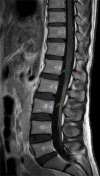Guillain-Barre syndrome following the first dose of the chimpanzee adenovirus-vectored COVID-19 vaccine, ChAdOx1
- PMID: 33888484
- PMCID: PMC8070856
- DOI: 10.1136/bcr-2021-242956
Guillain-Barre syndrome following the first dose of the chimpanzee adenovirus-vectored COVID-19 vaccine, ChAdOx1
Abstract
Prevention strategies for COVID-19 transmission are at the forefront of healthcare paradigms worldwide, the main emphasis of which is vaccination. We present an interesting case of a 37-year-old man who, 3 weeks following his first dose of the chimpanzee adenovirus-vectored COVID-19 vaccine, ChAdOx1, presented to hospital with a rapidly progressive ascending muscle weakness and back pain in the absence of any other triggers. He also had a negative COVID-19 swab during admission. A diagnosis of Guillain-Barre syndrome was confirmed by correlating the clinical features with cerebrospinal fluid analysis, nerve conduction studies and MRI of the brain and whole spine. The patient received treatment with 5 days of intravenous immunoglobulin and did not require any respiratory support. He was also regularly reviewed by a multidisciplinary team consisting of neurologists, speech and language therapists, and physiotherapists and is on the course to a recovery.
Keywords: COVID-19; healthcare improvement and patient safety; neurology; radiology; vaccination/immunisation.
© BMJ Publishing Group Limited 2021. No commercial re-use. See rights and permissions. Published by BMJ.
Conflict of interest statement
Competing interests: None declared.
Figures




References
-
- World Health Organisation [Internet] . WHO coronavirus disease (COVID-19) Dashboard, 2020. Available: https://covid19.who.int/
-
- NHS England and NHS Improvement coronavirus [Internet] . Vaccination information from other organisations. Available: https://www.england.nhs.uk/coronavirus/covid-19-vaccination-programme/ke...
-
- GOV.UK [Internet] . Information for UK recipients on COVID-19 vaccine Moderna, 2021. Available: https://www.gov.uk/government/publications/regulatory-approval-of-covid-...
Publication types
MeSH terms
Substances
LinkOut - more resources
Full Text Sources
Medical
